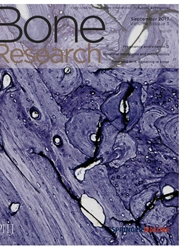

 中文摘要:
中文摘要:
Mechanical forces play critical roles in the development and remodeling processes of bone.As an alternative cell source for bone engineering,adipose-derived stem cells(ASCs)should be fully investigated for their responses to mechanical stress.Similarly,the osteogenic potential,stimulated by mechanical stress,should be compared with bone marrow stromal cells(BMSCs),which have been clinically used for bone tissue engineering.In this study,ASCs and BMSCs were osteogenic-induced for 48 hours,and then subjected to uniaxial mechanical stretching for 2 or 6 hours.Cell orientation,osteogenic regulatory genes,osteogenic genes and ALP activities were measured and compared between ASCs and BMSCs.ASCs could align in a perpendicular way to the direction of stretching stress,while BMSCs did not present a specific alignment.Both 2 and 6 hours mechanical stretching could enhance the mRNA expression of Osx and Runx2 in BMSCs and ASCs,while OCN mRNA only increased in ASCs after 6 hours mechanical loading.Mechanical stretching enhanced the BMP-2 mRNA expression in ASCs,while only after 6 hours of mechanical loading significantly increased the BMP-2 gene expression in BMSCs.Significant differences only exist between ASCs and BMSCs loaded at 2 hours of mechanical stretching.It is concluded that ASCs are more rapid responders to mechanical stress,and have greater potential than BMSCs in osteogenesis when stimulated by mechanical stretching,indicating their usefulness for bone study in a rat model.
 英文摘要:
英文摘要:
Mechanical forces play critical roles in the development and remodeling processes of bone. As an alternative cell source for bone engineering, adipose-derived stem cells (ASCs) should be fully investigated for their responses to mechanical stress. Similarly, the osteogenic potential, stimulated by mechanical stress, should be compared with bone marrow stromal cells (BMSCs), which have been clinically used for bone tissue engineering. In this study, ASCs and BMSCs were osteogenic-induced for 48 hours, and then subjected to uniaxial mechanical stretching for 2 or 6 hours. Cell orientation, osteogenic regulatory genes, osteogenic genes and ALP activities were measured and compared between ASCs and BMSCs. ASCs could align in a perpendicular way to the direction of stretching stress, while BMSCs did not present a specific alignment. Both 2 and 6 hours mechanical stretching could enhance the mRNA expression of Osx and Runx2 in BMSCs and ASCs, while OCN mRNA only increased in ASCs after 6 hours mechanical loading. Mechanical stretching enhanced the BMP-2 mRNA expression in ASCs, while only after 6 hours of mechanical loading significantly increased the BMP-2 gene expression in BMSCs. Significant differences only exist between ASCs and BMSCs loaded at 2 hours of mechanical stretching. It is concluded that ASCs are more rapid responders to mechanical stress, and have greater potential than BMSCs in osteogenesis when stimulated by mechanical stretching, indicating their usefulness for bone study in a rat model.
 同期刊论文项目
同期刊论文项目
 同项目期刊论文
同项目期刊论文
 Regeneration of articular cartilage by adipose tissue derived mesenchymal stem cells: perspectives f
Regeneration of articular cartilage by adipose tissue derived mesenchymal stem cells: perspectives f Characterization of a-smooth muscle actin positive cells during multilineage differentiation of dent
Characterization of a-smooth muscle actin positive cells during multilineage differentiation of dent Effects of bone morphogenetic protein-4 (BMP-4) on adipocyte differentiation from mouse adipose-deri
Effects of bone morphogenetic protein-4 (BMP-4) on adipocyte differentiation from mouse adipose-deri BMP4 promotes vascularization of human adipose stromal cells and endothelial cells in vitro and in v
BMP4 promotes vascularization of human adipose stromal cells and endothelial cells in vitro and in v Tetraploid complementation proves pluripotency of induced pluripotent stemcells derived from adipose
Tetraploid complementation proves pluripotency of induced pluripotent stemcells derived from adipose Poly(3-hydroxybutyrate-co-4-hydroxybutyrate) Based Electrospun 3D Scaffolds for Delivery of Autogene
Poly(3-hydroxybutyrate-co-4-hydroxybutyrate) Based Electrospun 3D Scaffolds for Delivery of Autogene Physiological oxygen tension modulates soluble growth factor profile after crosstalk between chondro
Physiological oxygen tension modulates soluble growth factor profile after crosstalk between chondro Surface characterization and osteoblast response to a functionally graded hydroxyapatite/fluoro-hydr
Surface characterization and osteoblast response to a functionally graded hydroxyapatite/fluoro-hydr Development Course and an Application Strategy for Induced Pluripotent Stem Cells in Regenerative Me
Development Course and an Application Strategy for Induced Pluripotent Stem Cells in Regenerative Me Smad signal pathway regulates angiogenesis via endothelial cell in an adipose-derived stromal cell/e
Smad signal pathway regulates angiogenesis via endothelial cell in an adipose-derived stromal cell/e Independent effect of polymeric nanoparticle zeta potential/surface charge on their cytotoxicity and
Independent effect of polymeric nanoparticle zeta potential/surface charge on their cytotoxicity and TGFβ signalling pathway regulates angiogenesis by endothelial cells, in an adipose-derived stromal c
TGFβ signalling pathway regulates angiogenesis by endothelial cells, in an adipose-derived stromal c Polyphenol-Functionalized Graphene/Chitosan as an Experimental Platform with Improved Mechanical Beh
Polyphenol-Functionalized Graphene/Chitosan as an Experimental Platform with Improved Mechanical Beh Insight into the Interaction of Graphene Oxide with Serum Proteins and the Impact of the Degree of R
Insight into the Interaction of Graphene Oxide with Serum Proteins and the Impact of the Degree of R Regulation of Extracellular Matrix Remodeling Proteins by Osteoblasts in nanoscaled-Ti particle-indu
Regulation of Extracellular Matrix Remodeling Proteins by Osteoblasts in nanoscaled-Ti particle-indu Adventitial Cells and Perictyes Support Chondrogenesis through Different Mechanisms in 3-Dimensional
Adventitial Cells and Perictyes Support Chondrogenesis through Different Mechanisms in 3-Dimensional Gene profile of soluble growth factors involved in angiogenesis in an adipose-derived stromal cell/e
Gene profile of soluble growth factors involved in angiogenesis in an adipose-derived stromal cell/e 期刊信息
期刊信息
